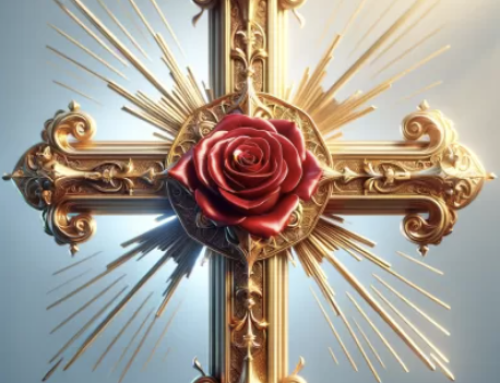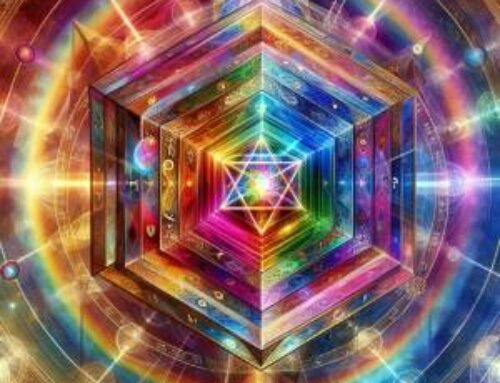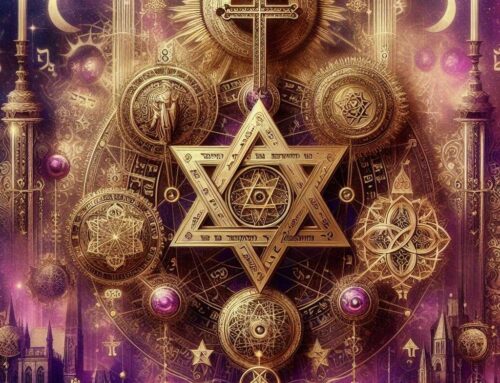Contents
- 1 Introduction
- 2 Historical Origins and Influences
- 3 Key Philosophies and Teachings
- 4 Rituals and Ceremonies
- 5 Influential Figures in the Golden Dawn
- 6 Modern Adaptations and Legacy
- 7 Comparative Analysis with Other Mystical Traditions
- 8 Rosicrucian System of the Order
- 9 The closure of the Golden Dawn
- 10 Post Golden Dawn Branches
- 11 Conclusion of “Golden Dawn Rosicrucian”
- 12 FAQ – Golden Dawn Rosicrucian
- 13 Reference:
Introduction
The Hermetic Order of the Golden Dawn (HOGD), intertwined with Rosicrucian principles, stands as a beacon of Western esoteric tradition, casting a long shadow over contemporary mystical practices. Founded in the late 19th century, this secretive society sought to unlock the secrets of the universe, blending elements from various mystical traditions including Kabbalah, Hermeticism, and the lore of the ancient Rosicrucians. It was not merely an organization but a complex system of spiritual development, offering a structured path for personal transformation through the study of the occult and metaphysics.

The Golden Dawn’s philosophy was deeply embedded in the belief that there exists a hidden knowledge, accessible only to the worthy, that could unveil the workings of the cosmos and the true nature of humanity. Members underwent rigorous training, progressing through degrees of initiation, each revealing deeper layers of esoteric knowledge.
This journey was not for the faint of heart; it demanded dedication, discretion, and a profound desire for spiritual growth (3).
The Golden Dawn Rosicrucian order represents a fusion of mystical practices and ancient wisdom. The Order’s impact extends beyond its original London-based milieu, influencing modern New Age movements and continuing to fascinate those drawn to the mystic’s path. Its legacy is a testament to the enduring human quest for understanding and transcendence, making it a subject of endless fascination and study. In exploring the Golden Dawn and its Rosicrucian connections, we uncover not just a historical curiosity but a living stream of wisdom, relevant to anyone seeking deeper spiritual insights.
Historical Origins and Influences
The Birth of a Tradition
The Hermetic Order of the Golden Dawn emerged in the late 19th century, born out of a convergence of various esoteric traditions. It drew heavily from the Rosicrucian heritage, itself a mystical philosophical secret society said to have been founded in late medieval Germany. This amalgamation of ideas created a unique system of spiritual practice that sought to unravel the mysteries of existence. The Hermetic Order of the Golden Dawn was one of the first Rosicrucian-style orders in which women had access, a departure from the tradition of such orders being exclusively for men.
Cross-Cultural Influences
The Golden Dawn did not exist in isolation; it was the product of a rich tapestry of influences, including Egyptian mythology, Christian mysticism, and the teachings of the Renaissance alchemists. This eclectic mix contributed to the Order’s comprehensive approach to spiritual development, one that appealed to a broad audience of seekers. The Golden Dawn Rosicrucian movement has significantly influenced modern Western esotericism (1).
Foundational Texts and Concepts
The Golden Dawn Rosicrucian texts are rich with symbolic language and hidden meanings. Central to the Golden Dawn’s teachings were several key texts and concepts, including the Cipher Manuscripts, which served as the foundation for much of the Order’s ritualistic practices. These documents, along with the influence of earlier works on Hermeticism and Kabbalah, guided the initiation rites and philosophical teachings of the Order.
Key Philosophies and Teachings
The Quest for Gnosis
At the heart of the Golden Dawn’s teachings was the pursuit of gnosis – direct knowledge of the divine. This was not an intellectual exercise but a deeply personal journey of spiritual awakening and transformation.
The Structure of the Cosmos
Members of the Golden Dawn were introduced to a complex cosmology that included the Tree of Life from Kabbalah, serving as a map for spiritual ascent. This symbolic framework helped initiates understand their place in the universe and the steps necessary to achieve enlightenment.
Ethics and Personal Development
Initiates of the Golden Dawn Rosicrucian tradition often explore the depths of esoteric knowledge. The ethical teachings of the Golden Dawn emphasized personal integrity, self-discipline, and the importance of service to humanity. Initiates were encouraged to develop virtues that would not only advance their own spiritual growth but also contribute to the betterment of the world.
Rituals and Ceremonies
Initiation Rites
Rituals within the Golden Dawn Rosicrucian framework are designed to awaken higher states of consciousness. The Golden Dawn’s system of initiation was elaborate and symbolic, designed to gradually expose members to higher levels of esoteric knowledge. Each degree of initiation corresponded to a specific level of spiritual development and mastery.
Magic and Symbolism
Ritual magic was a significant aspect of the Golden Dawn’s practice, involving the use of symbols, invocations, and ceremonial tools. These practices were believed to facilitate communication with divine forces and aid in the initiate’s spiritual journey.
Daily Practices and Meditation
Beyond the formal ceremonies, members were also instructed in daily practices and meditation techniques to foster spiritual awareness and growth. These practices were integral to the holistic development approach advocated by the Order.
Influential Figures in the Golden Dawn
Founders and Early Leaders
The Golden Dawn was established by three Freemasons: William Robert Woodman, William Wynn Westcott, and Samuel Liddell MacGregor Mathers. Their vision and leadership were instrumental in shaping the Order’s early development.
Famous Members
The Order attracted many prominent figures of the time, including poets, artists, and intellectuals. W.B. Yeats, Aleister Crowley, Arthur Edward Waite, Michael Whitty, Paul Foster Case, Robert Felkin, Annie Horniman, Arthur Machen, Pamela Colman Smith, Charles Henry Allan Bennett, Florence Farr, and Algernon Blackwoodwere among its most famous members, each contributing to the Golden Dawn’s legacy in unique ways. The Hermetic Order of the Golden Dawn, renowned for its contribution to Western esoteric tradition, also inspired the formation of various offshoot groups. Notably, several famous members were not directly part of the original Golden Dawn but were affiliated with these offshoots like Dion Fortune or Israel Regardie.
Legacy and Influence
The contributions of these individuals extended beyond their lifetimes, influencing contemporary spiritual movements and contributing to the enduring fascination with the Golden Dawn.
It didn’t take long for the Hermetic Order of the Golden Dawn to establish a global presence, with European temples in London and Paris, followed by expansions into the United States and Australia. The temple in Australia, in particular, stood out for its longevity and its unique approach. Despite having a curriculum and materials that differed from those of the European branch, the Australian temple successfully carried on the tradition, demonstrating the adaptability and enduring appeal of the Golden Dawn’s teachings across different cultures and regions.
Modern Adaptations and Legacy
Continuing Influence
Some authentic organizations were offsprings of the Hermetic Order of the Golden Dawn, yet none adopted the original name of the now-defunct society. Ritual fragments published by individuals, who were not direct initiates of the Golden Dawn but rather associated with its offshoots, were rife with errors. The system of the Golden Dawn is often seen as lacking coherence, with its rituals and teachings filled with errors. This aspect has been pointed out not as a criticism but as a statement of fact, highlighting challenges in maintaining the integrity of its esoteric practices.
The Golden Dawn in Popular Culture
The mystique of the Golden Dawn has permeated popular culture, inspiring novels, films, and music. This has helped to keep the Order’s teachings alive in the public imagination, drawing new generations of seekers to explore its wisdom.
Comparative Analysis with Other Mystical Traditions
Similarities and Differences
The Golden Dawn’s teachings can be compared and contrasted with those of other mystical traditions, such as Sufism, Buddhism, and the mystical branches of Christianity and Judaism. This analysis highlights the universal themes of spiritual seeking and the unique contributions of each tradition.
Syncretism and Eclecticism
The Golden Dawn’s approach was inherently syncretic, drawing from a wide range of sources. This eclecticism is a hallmark of the Order, distinguishing it from traditions with a more singular focus.
The Quest for Unity
Despite the differences, all these paths share a common goal: the pursuit of spiritual truth and unity with the divine. The Golden Dawn’s teachings offer one route among many, each valuable in its own right for the insights it provides into the human spirit.
Rosicrucian System of the Order
The original system of the Golden Dawn primarily focuses on the initiatory system of the lesser degrees of the Tree of Life from Kabbalah (lesser work of alchemy), distinguishing it from a purely Rosicrucian order. However, as the system evolved, a higher system, under a different order’s name, was developed for the greater mysteries, incorporating Rosicrucian elements. Consequently, it is the adept grades that truly establish the Rosicrucian connection within the order. This evolution signifies that the Golden Dawn’s system is a blend of different traditions, lacking a coherent initiatory system that spans all levels of the Tree of Life.
The closure of the Golden Dawn
The closure of the Hermetic Order of the Golden Dawn and the scandals associated with it stem from a combination of internal conflicts, leadership disputes, and controversies surrounding some of its most notable members. By the early 20th century, the order faced significant challenges due to disagreements over its direction, allegations of misconduct, and the sensationalist activities of figures like Aleister Crowley, which attracted public scrutiny and criticism. These issues, compounded by a broader societal skepticism towards occult practices, led to the order’s fragmentation and eventual disbandment. The combination of internal strife and external pressures highlighted the difficulties inherent in maintaining a secretive and esoteric organization within a changing social landscape.
Post Golden Dawn Branches
Students should understand that any branches founded after the Golden Dawn’s closure, using the Name “Golden Dawn” and claiming to be direct successors, are not genuine. The decision to close the original order was driven by the need to address its structural shortcomings and to establish a new, more robust framework. The original system was not only flawed but also lacked a legitimate connection to the authentic, rich European Rosicrucian tradition. This observation is not a critique but a factual clarification meant to guide seekers towards genuine spiritual paths
Conclusion of “Golden Dawn Rosicrucian”
The Hermetic Order of the Golden Dawn, with its rich Rosicrucian heritage, offers a profound journey into the heart of spiritual alchemy and esoteric wisdom. Its historical origins, key teachings, and the legacy it has left behind speak to the timeless human quest for knowledge and transformation. As we explore the Order’s rituals, influential figures, modern adaptations, and its place within the broader tapestry of mystical traditions, we uncover a fascinating narrative of spiritual exploration and growth.
The Golden Dawn’s synthesis of various mystical traditions into a cohesive system of spiritual development exemplifies the beauty of esoteric study: its capacity to bridge diverse paths in the pursuit of universal truths. This exploration serves not only as an academic inquiry but as a beacon for those seeking deeper understanding and connection in their own spiritual journeys.
Profound Initiatory Path
The Hermetic Academy, dedicated to preserving and advancing sacred teachings, invites you to embark on an initiatory journey of enlightenment and mystical exploration. Whether you’re drawn to the ancient wisdom of the Rosicrucians, the intricate rituals of the Golden Dawn, or the profound insights of Hermetic philosophy, the Academy provides a structured and profound initiatory path toward spiritual growth and mastery. Embrace the opportunity to transform your life and contribute to a more enlightened world. Your journey begins now – at the Hermetic Academy.
FAQ – Golden Dawn Rosicrucian
1. What is the Hermetic Order of the Golden Dawn?
The Golden Dawn was a secret initiatory society dedicated to the study and practice of the occult, metaphysics, and paranormal activities. It was founded in the late 19th century and is known for its comprehensive system of magical training and spiritual development.
2. Who were the founders of the Golden Dawn?
The Order was founded by William Robert Woodman, William Wynn Westcott, and Samuel Liddell MacGregor Mathers, all of whom were Freemasons and deeply interested in the occult.
3. What are the key teachings of the Golden Dawn?
The Golden Dawn’s teachings encompassed Hermeticism, Kabbalah, astrology, tarot, alchemy, and theurgy. Its teachings aimed at personal transformation through the acquisition of esoteric knowledge and spiritual enlightenment.
4. How did the Golden Dawn influence modern spiritual practices?
The Golden Dawn has had a significant impact on contemporary New Age and occult practices, influencing modern ceremonial magic, the revival of paganism, and the interpretation of esoteric traditions (2).
5. Can one still join the Golden Dawn today?
No, the original Hermetic Order of the Golden Dawn has not existed for more than 100 years. There are various offshoots with different names that continue its traditions.
Reference:
(1)Drury, Nevill, ‘Freemasons and the Rose Cross’, Stealing Fire from Heaven: The Rise of Modern Western Magic (2011; online edn, Oxford Academic, 1 May 2011), https://doi.org/10.1093/acprof:oso/9780199750993.003.0003, accessed 22 Mar. 2024.
(2)Asprem E. The Golden Dawn and the O.T.O. In: Magee GA, ed. The Cambridge Handbook of Western Mysticism and Esotericism. Cambridge University Press; 2016:272-283.
(3)Rubenstein, E. (2020). The Tree of Life: The Kabbalah of Immortality. Hermetic World, Paphos.





